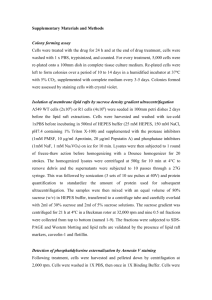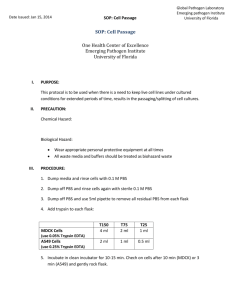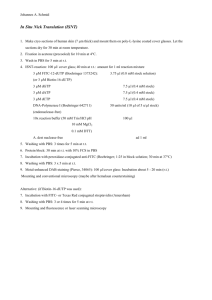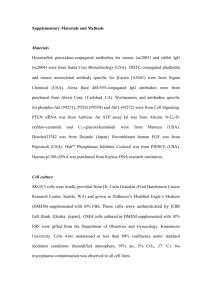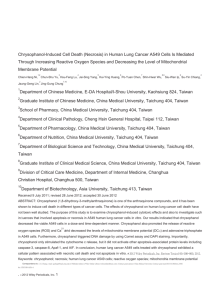Cytosolic and mitochondrial protein extraction
advertisement
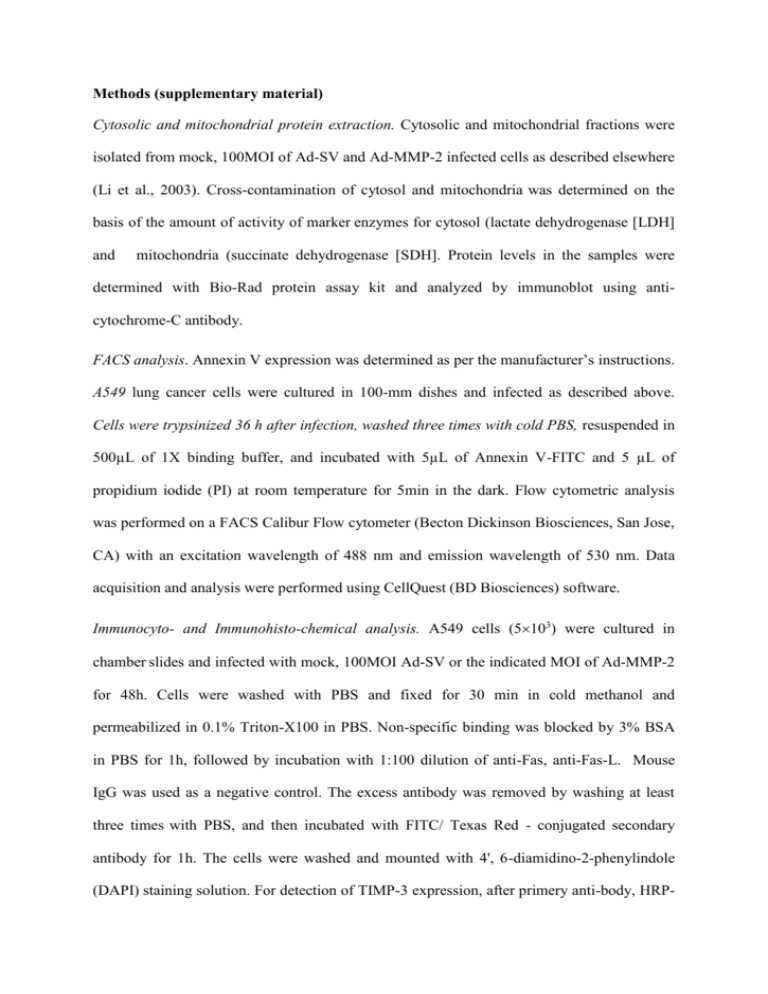
Methods (supplementary material) Cytosolic and mitochondrial protein extraction. Cytosolic and mitochondrial fractions were isolated from mock, 100MOI of Ad-SV and Ad-MMP-2 infected cells as described elsewhere (Li et al., 2003). Cross-contamination of cytosol and mitochondria was determined on the basis of the amount of activity of marker enzymes for cytosol (lactate dehydrogenase [LDH] and mitochondria (succinate dehydrogenase [SDH]. Protein levels in the samples were determined with Bio-Rad protein assay kit and analyzed by immunoblot using anticytochrome-C antibody. FACS analysis. Annexin V expression was determined as per the manufacturer’s instructions. A549 lung cancer cells were cultured in 100-mm dishes and infected as described above. Cells were trypsinized 36 h after infection, washed three times with cold PBS, resuspended in 500µL of 1X binding buffer, and incubated with 5µL of Annexin V-FITC and 5 µL of propidium iodide (PI) at room temperature for 5min in the dark. Flow cytometric analysis was performed on a FACS Calibur Flow cytometer (Becton Dickinson Biosciences, San Jose, CA) with an excitation wavelength of 488 nm and emission wavelength of 530 nm. Data acquisition and analysis were performed using CellQuest (BD Biosciences) software. Immunocyto- and Immunohisto-chemical analysis. A549 cells (5103) were cultured in chamber slides and infected with mock, 100MOI Ad-SV or the indicated MOI of Ad-MMP-2 for 48h. Cells were washed with PBS and fixed for 30 min in cold methanol and permeabilized in 0.1% Triton-X100 in PBS. Non-specific binding was blocked by 3% BSA in PBS for 1h, followed by incubation with 1:100 dilution of anti-Fas, anti-Fas-L. Mouse IgG was used as a negative control. The excess antibody was removed by washing at least three times with PBS, and then incubated with FITC/ Texas Red - conjugated secondary antibody for 1h. The cells were washed and mounted with 4', 6-diamidino-2-phenylindole (DAPI) staining solution. For detection of TIMP-3 expression, after primery anti-body, HRP- conjugated secondary antibody at 1:200 dilution and 3,3-diaminobenzidine (DAB peroxidase substrate) solution were used. The slides were counterstained with hematoxylin and mounted. The bright field images were captured with an Olympus BX 60 research fluorescence microscope attached with CCD camera. For immunohistochemical analysis, tissue sections (4-5 µm-thick) were deparaffinized in xylene, rehydrated in graded ethanol solutions, washed with PBS and permeabilized in 0.1% Triton X-100 and incubated overnight with primary antibodies for Fas, Fas-L, TIMP-3 and cleaved Bid and processed as described above. Extraction of extracellular matrix (ECM) protein. A549 lung cancer cells were infected as mentioned above for 48h. The cells were washed with PBS three times and then lysed with PBS containing 0.5% Triton X-100 (v/v) for 20 min at room temperature. After aspirating the Triton X-100, the remaining ECM was washed thrice with PBS followed by two washes with 20 mM Tris-HCl (pH 7.4) containing 100mM NaCl and 0.1% (v/v) Tween 20. The cells were observed under a light microscope to ensure that no un-lysed cells were left in the culture dish. Sample buffer (200L) was added to each culture dish and cells were agitated for 20 min on a rocker at room temperature. Using 25L of these extracts immunoblot analysis for TIMP-3 was performed as mentioned above. Terminal deoxynucleotidyl transferase-mediated nick labeling (TUNEL) assay. We detected apoptosis in Ad-MMP-2-treated cells as well as the subcutaneous tumor tissue sections of Ad-MMP-2-treated mice using terminal deoxynucleotidyl transferase dUTP nick-end labeling (TUNEL) enzyme reagent and 4,6-diamidno-2-phenylindole according to the manufacturer’s instructions. Briefly, 5103 cells were plated in 8-well chamber slides and infected as described above. After 48h, cells were washed three times with PBS, fixed 4% paraformaldehyde in PBS for 1h at 15-25°C, washed with PBS and permeabilized in 0.1% Triton-X100 in 0.1% sodium citrate in PBS for 2 min (for cells) or 8 min (for tissue sections) on ice. Slides were then washed with PBS and incubated in TUNEL reaction mixture in a humidified atmosphere for 1h at 37°C in the dark, washed and mounted onto slides with GEL/MOUNT Aqueous Mounting Medium with Anti-Fading Agents. The cells were also counter stained with 4’, 6-diamidino-2-phenylindole (DAPI) nuclear staining mounting solution. To determine the number of apoptotic cells in the tissue sections, paraffin-embedded tissue sections were deparaffinize and rehydrated. Slides were imaged with an Olympus BX 60 research fluorescence microscope attached with CCD camera. The apoptotic index was defined as follows: apoptotic index (%) = 100 × (apoptotic cells/total cells). Results (supplementary material) Neutralization of Fas-L with anti-Fas-L antibody reverses Fas-mediated apoptosis. To confirm whether Fas and Fas-L were involved in mediating this increase in apoptosis, A549 cells were incubated for 1h with neutralizing antibodies against Fas-L prior to infection with Ad-MMP-2. This pretreatment of A549 cells reduced TUNEL staining (Fig. 4A) in AdMMP-2-infected cells by >45% from an average 705% to 303% apoptotic cells (Fig. 4B). This result was confirmed by immunoblotting for the downstream mediators of Fas-mediated apoptosis, caspase-8 and PARP-1 cleavage. As shown in Figure 4C, caspase-8 and PARP-1 cleavage were inhibited when cells were pretreated with anti-Fas-L. The Ad-MMP-2 induced apoptosis was not reverted back in non-specific antibody treated A549 cells (Fig. 4D). These results strongly suggest that the Ad-MMP-2-induced apoptosis is mediated by the Fas/Fas-L pathway. Pancaspase inhibitors and caspase-8 specific inhibitor blocked Ad-MMP-2-induced apoptosis. To further demonstrate the activation of caspases during Ad-MMP-2-induced apoptosis, the apoptotic effect of pancaspase inhibitors, as well as specific caspase inhibitors for caspase-8 and caspase-9, was examined. The specific caspase inhibitors were Z-VADFMK for pancaspase, Z-IETD-FMK for caspase-8, and Z-LEHD-FMK for caspase-9. The various concentrations of these caspase inhibitors did not affect the viability of the A549 cells (data not shown). First, as shown in Fig. 2D, we observed that the general caspase antagonist, Z-VAD-FMK inhibited Ad-MMP-2-induced apoptosis as determined by inhibition of cleavage of PARP and caspases-8, and -9. Pretreatment of cultured A549 cells with 25µM of the caspase-8-specific inhibitor, Z-IETD-FMK clearly suppressed the activation of caspases-9 and blocked PARP cleavage. However pretreatment with caspase-9 inhibitor, Z-LEHD-FMK inhibited caspase-9 cleavage but did not affect caspase-8 cleavage, suggesting that caspase-8 functions upstream of caspase 9. These findings constitute the first evidence that the mostupstream change in the caspase cascade that occurs in Ad-MMP-2 apoptotic cells is the activation of caspase-8. We further demonstrate that MMP-2 inhibitor 1, a specific inhibitor of MMP-2 also induced apoptosis as determined by cleavage of caspase-8 and PARP-1 (Fig. 2E).
